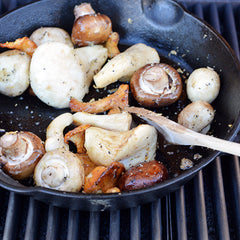Most of us are familiar with a few kinds of commercially available mushrooms. We put them in our brown paper bags at the supermarket and they're delicious. But did you know that Canada is a terrific place to hunt and gather wild mushrooms? Yep, true. The world, as they say, is your oyster (mushroom).

Remember that scene from 'The Road'? Where the man and his son find some wild mushrooms inconceivably growing in the grey, miasmic, post-apocalyptic world? Well, you can be like that nameless man and do some fungal hunting and gathering. Of course, you have to be cautious when eating wild mushrooms. Some of them are hard on the tum-tum and some of them can even force you to give up the oxygen habit.

In Edmonton there's a group of nice folks known as the 'Alberta Mycological Society' (and if you think that's a cool name check this out - the name of one of their get togethers in Edmonton is known as 'The City of Champignons' - awesome). These folks spend a LOT of time looking for, gathering, photographing, and just generally talking about…mushrooms. Check out their cool, very mushroomy website at www.wildmushrooms.ws.
Here's a few interesting things they had to say about grilling mushrooms:
The most common edible wild mushrooms found and consumed in Canada are:
Morels

Edible mushrooms with a distinctive honeycomb-like shape. It's name is derived from the latin word 'maurus' which means brown. Very original... That said, there can be yellow, grey and black species in the morchella genus.
Best prepared by sautéing in butter and adding a touch of salt and pepper. Great in meat dishes and soup. MUST be cooked before eating. Unless you want to be very sick
Chanterelles

Chanterelles are always a yellow-orange colour and are a typically meaty mushroom with a 'gilly' underside and a smooth top. They grow in clusters mostly within coniferous forests but have been found in mountains and grasslands in many countries across the globe.
High in vitamin C, vitamin D and potassium, chanterelle mushrooms made their debut as a culinary delicacy in the French cuisine of the 18th century. Golden chanterelles are in the same elite class of mushrooms as truffles and morels, with a similar price tag. They lend themselves well to recipes involving alcohol or wines.
Oyster

Oyster mushrooms are some of the most popular edible mushrooms. Often torn up instead of sliced, oyster mushrooms are great for stir frys and sautés. They can be found in both temperate and tropical climates.
Some mushrooms found in Canada that lend themselves particularly well to the high heat of grilling are:
Giant Western Puffball (!)

In a shocking turn of events, the Giant Western Puffball is shaped like - you guessed it - a puffball! It can grow up to a whopping 70 centimetres in diameter. Typically grows in meadows, fields, pastures and forests (because what else is there in the West, other than mountains?). The surface is covered in white or tan "warts".
When cooking make sure that they are entirely white inside - or you'll be sorry. We know that green usually means go, but not in this case. Dirt should be trimmed off as they are difficult to wash. Extremely versatile and can be cooked in just about any way.
Portobello

Fungi fact: Portobello mushrooms are actually mature button and cremini mushrooms. Who knew! Well, I'm sure someone knew. This genus of mushroom is found in over 70 countries across the world. The caps of the mushrooms change into a more flattened shape as the mushroom matures.
Shaggy Parasol

This species of mushroom features thick brown scales on a flashy white cap slapped on top of a slender stem. Another mushroom that you need to make sure is well cooked to avoid upset tummies. It's identical twin is actually a mushroom responsible for the most poisonings in North America. Not for the beginner mushroom hunter!
And as to whether wild mushrooms taste different than domestic mushrooms: Each species of wild mushroom has its own unique taste. Mushrooms from the wild take on a flavour specific to their hosts (tree, grass, moss etc.), so yes, a wild edible mushroom will taste different (not necessarily better or worse) than a commercially raised mushroom. And now for some mushroom hunting tips:

Most experts advise to start your mushroom hunting career with an expert and, always carry a field guide with you to help with identification. We're lucky, we have a four-footed, in-house expert that is capable of helping with any and all hunting related issues. Our mushroom-specific expert Angelo (not pictured) is old-school. He advises that you first need to identify that a mushroom is safe to eat. Then, cut the stem of the mushroom and look for tiny worms in the stem. Worms are good. If it's healthy for them to eat it - it's healthy for us.

Take pictures of the mushrooms you collect. That way you can build your own archive of edible wild mushrooms that you've collected (and, as a side benefit, if you've accidentally plucked and eaten the rare 'Shroud of Quick, Painful Death' mushroom, you will have a visual record of the fungi that put you into the ER). Oh, and don't put your mushrooms in a plastic bag after you've collected them - paper only.
Here are some recipes using mushrooms!
- Portobello Mushroom "Cheese Burgers"
- Cedar Planked Brie with Oyster Mushroom
- Bloody Caesar New York Steaks








